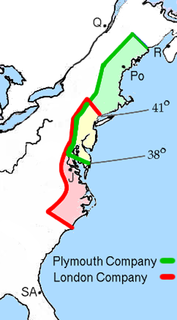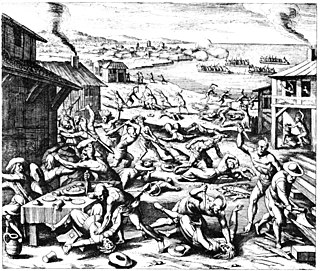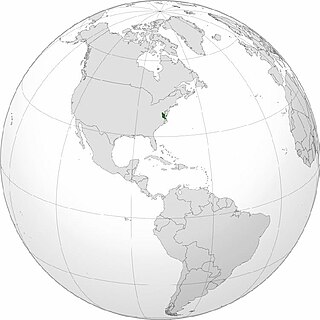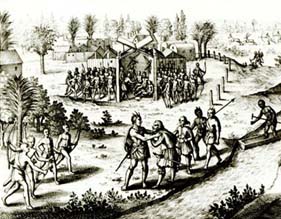
The Colony of Virginia, chartered in 1606 and settled in 1607, was the first enduring English colony in North America, following failed proprietary attempts at settlement on Newfoundland by Sir Humphrey Gilbert in 1583, and the subsequent farther south Roanoke Island by Sir Walter Raleigh in the late 1580s.

Pocahontas was a Native American woman, belonging to the Powhatan people, notable for her association with the colonial settlement at Jamestown, Virginia. She was the daughter of Powhatan, the paramount chief of a network of tributary tribes in the Tsenacommacah, encompassing the Tidewater region of Virginia.

The London Company, officially known as the Virginia Company of London, was a division of the Virginia Company with responsibility for colonizing the east coast of America between latitudes 34° and 41° N.

The Powhatan people may refer to any of the indigenous Algonquian people that are traditionally from eastern Virginia. All of the Powhatan groups descend from the Powhatan Confederacy. In some instances, The Powhatan may refer to one of the leaders of the people. This is most commonly the case in historical records from English colonial accounts. The Powhatans have also been known as Virginia Algonquians, as the Powhatan language is an eastern-Algonquian language, also known as Virginia Algonquian. It is estimated that there were about 14,000–21,000 Powhatan people in eastern Virginia, when English colonists established Jamestown in 1607.

Opechancanough was paramount chief of the Powhatan Confederacy in present-day Virginia from 1618 until his death. He had been a leader in the confederacy formed by his older brother Powhatan, from whom he inherited the paramountcy.
Sir George Yeardley (1587–1627) was a planter and colonial governor of the colony of Virginia. He was also among the first slaveowners in Colonial America. A survivor of the Virginia Company of London's ill-fated Third Supply Mission, whose flagship, the Sea Venture, was shipwrecked on Bermuda for ten months from 1609 to 1610, he is best remembered for presiding over the initial session of the first representative legislative body in Virginia in 1619. With representatives from throughout the settled portion of the colony, the group became known as the House of Burgesses. It has met continuously since, and is known in modern times as the Virginia General Assembly. Yeardley died in 1627.

The Paspahegh tribe were tributaries to the Powhatan paramount chiefdom, incorporated into the chiefdom around 1596 or 1597. The Paspahegh Indian tribe lived in present-day Charles City and James City counties, Virginia. The Powhatan tribes were a group of Native Americans who spoke a branch of Algonquian language.

The Indian massacre of 1622, popularly known as the Jamestown massacre, took place in the English Colony of Virginia, in what is now the United States, on 22 March 1622. John Smith, though he had not been in Virginia since 1609 and was not an eyewitness, related in his History of Virginia that warriors of the Powhatan "came unarmed into our houses with deer, turkeys, fish, fruits, and other provisions to sell us". The Powhatan then grabbed any tools or weapons available and killed all the English settlers they found, including men, women, children of all ages. Chief Opechancanough led the Powhatan Confederacy in a coordinated series of surprise attacks, and they killed a total of 347 people, a quarter of the population of the Virginia colony.
Colonel Edmund Scarborough was an influential early settler of Virginia and member of the Virginia House of Burgesses from 1642 to 1671.

Tsenacommacah is the name given by the Powhatan people to their native homeland, the area encompassing all of Tidewater Virginia and parts of the Eastern Shore. More precisely, its boundaries spanned 100 miles (160 km) by 100 miles (160 km) from near the south side of the mouth of the James River all the way north to the south end of the Potomac River and from the Eastern Shore west to about the Fall Line of the rivers.

The Anglo–Powhatan Wars were three wars fought between settlers of the Virginia Colony and Algonquin Indians of the Powhatan Confederacy in the early seventeenth century. The first war started in 1609 and ended in a peace settlement in 1614. The second war lasted from 1622 to 1626. The third war lasted from 1644 until 1646 and ended when Opechancanough was captured and killed. That war resulted in a defined boundary between the Indians and colonial lands that could only be crossed for official business with a special pass. This situation lasted until 1677 and the Treaty of Middle Plantation which established Indian reservations following Bacon's Rebellion.
Kiskiack was a Native American tribal group of the Powhatan Confederacy in what is present-day York County, Virginia. The name means "Wide Land" or "Bread Place" in the native language, one of the Virginia Algonquian languages. It was also the name of their village on the Virginia Peninsula.
Henry Spelman (1595–1623) was an English adventurer, soldier, and author, the son of Erasmus Spelman and nephew to Sir Henry Spelman of Congham (1562–1641). The younger Henry Spelman was born in 1595 and left his home in Norfolk, England at age 14 to sail to Virginia Colony aboard the ship Unity, as a part of the Third Supply to the Jamestown Colony in 1609. He is remembered for being an early interpreter for the people of Jamestown as well as writing the Relation of Virginia, documenting the first permanent English colonial settlement in North America at Jamestown, Virginia, and particularly the lifestyles of the Native Americans of the Powhatan Confederacy led by Chief Powhatan.

Jamestown, also Jamestowne, was the first settlement of the Virginia Colony, founded in 1607, and served as the capital of Virginia until 1699, when the seat of government was moved to Williamsburg. This article covers the history of the fort and town at Jamestown proper, as well as colony-wide trends resulting from and affecting the town during the time period in which it was the colonial capital of Virginia.
Richard Pace was an early settler and Ancient Planter of Colonial Jamestown, Virginia. According to a 1622 account published by the London Company, Richard Pace played a key role in warning the Jamestown colony of an impending Powahatan raid on the colony.
Colonel Obedience Robbins was a Burgess six times in Virginia during the 17th century.
Temperance Flowerdew, Lady Yeardley was an early settler of the Jamestown Colony and a key member of the Flowerdew family, significant participants in the history of Jamestown. Temperance Flowerdew was wife of two Governors of Virginia, sister of another early colonist, aunt to a representative at the first General Assembly and "cousin-german" to the Secretary to the Colony.
Edward Bennett, was an English merchant based in London, and a free member of the Virginia Company. A Puritan who had lived in Amsterdam for a period, he established the first large plantation in the colony of Virginia in North America, in what became known as Warrosquyoake Shire.

Captain Ralph Hamor (1589-1626) was one of the original colonists to settle in Virginia, and author of A True Discourse of the Present State of Virginia, which he wrote upon returning to London in 1615.
The Accomac people were a historic Native American tribe in Accomack and Northampton counties in Virginia. They were loosely affiliated with the Powhatan Confederacy.











